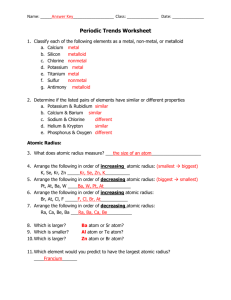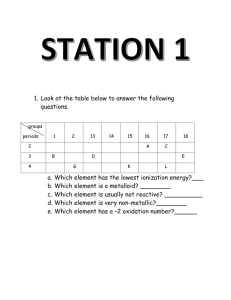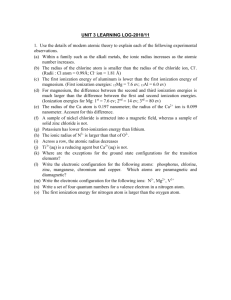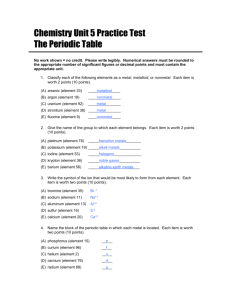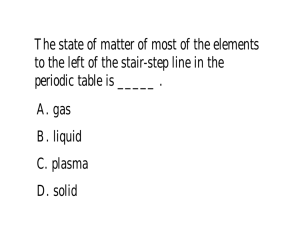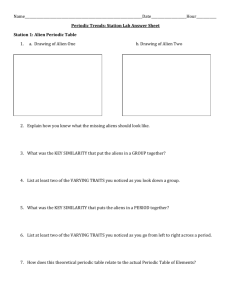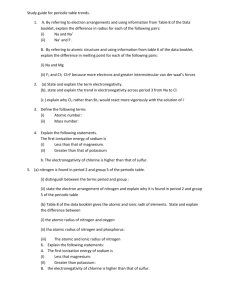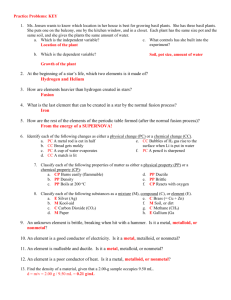Periodic review
advertisement
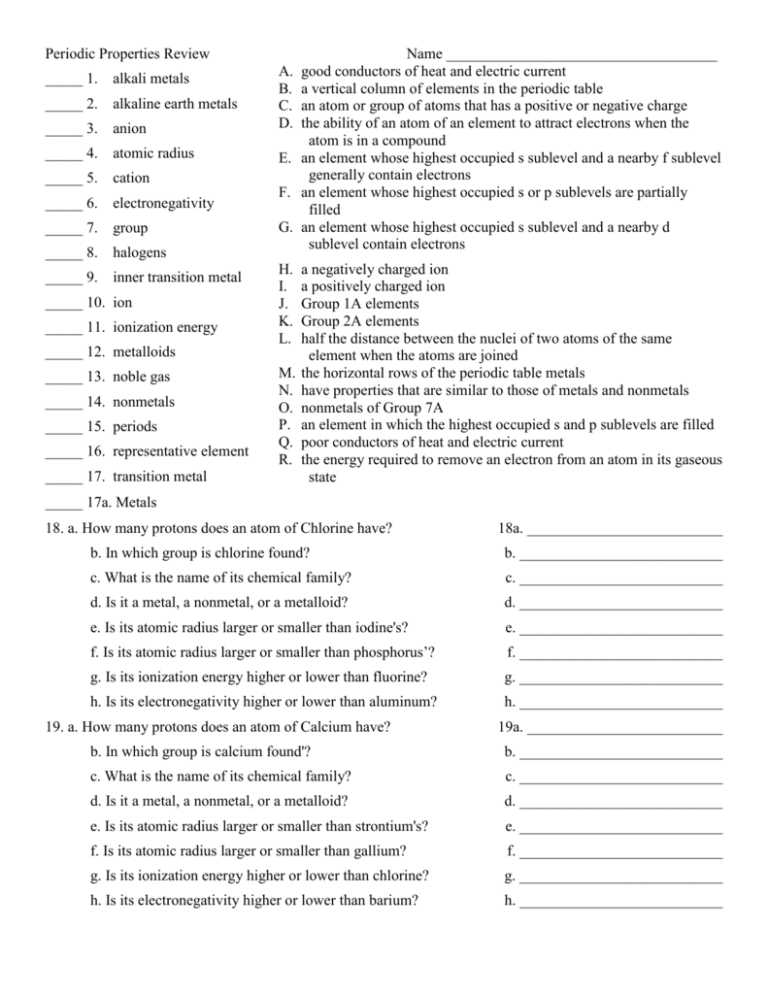
Periodic Properties Review _____ 1. alkali metals _____ 2. alkaline earth metals _____ 3. anion A. B. C. D. _____ 4. atomic radius E. _____ 5. cation _____ 6. electronegativity _____ 7. group _____ 8. halogens _____ 9. inner transition metal _____ 10. ion _____ 11. ionization energy _____ 12. metalloids _____ 13. noble gas _____ 14. nonmetals _____ 15. periods _____ 16. representative element _____ 17. transition metal F. G. H. I. J. K. L. M. N. O. P. Q. R. Name ____________________________________ good conductors of heat and electric current a vertical column of elements in the periodic table an atom or group of atoms that has a positive or negative charge the ability of an atom of an element to attract electrons when the atom is in a compound an element whose highest occupied s sublevel and a nearby f sublevel generally contain electrons an element whose highest occupied s or p sublevels are partially filled an element whose highest occupied s sublevel and a nearby d sublevel contain electrons a negatively charged ion a positively charged ion Group 1A elements Group 2A elements half the distance between the nuclei of two atoms of the same element when the atoms are joined the horizontal rows of the periodic table metals have properties that are similar to those of metals and nonmetals nonmetals of Group 7A an element in which the highest occupied s and p sublevels are filled poor conductors of heat and electric current the energy required to remove an electron from an atom in its gaseous state _____ 17a. Metals 18. a. How many protons does an atom of Chlorine have? 18a. __________________________ b. In which group is chlorine found? b. ___________________________ c. What is the name of its chemical family? c. ___________________________ d. Is it a metal, a nonmetal, or a metalloid? d. ___________________________ e. Is its atomic radius larger or smaller than iodine's? e. ___________________________ f. Is its atomic radius larger or smaller than phosphorus’? f. ___________________________ g. Is its ionization energy higher or lower than fluorine? g. ___________________________ h. Is its electronegativity higher or lower than aluminum? h. ___________________________ 19. a. How many protons does an atom of Calcium have? 19a. __________________________ b. In which group is calcium found'? b. ___________________________ c. What is the name of its chemical family? c. ___________________________ d. Is it a metal, a nonmetal, or a metalloid? d. ___________________________ e. Is its atomic radius larger or smaller than strontium's? e. ___________________________ f. Is its atomic radius larger or smaller than gallium? f. ___________________________ g. Is its ionization energy higher or lower than chlorine? g. ___________________________ h. Is its electronegativity higher or lower than barium? h. ___________________________ 20. a. How many protons does an atom of sodium have? 20 a. _________________________ b. In which group is sodium found? b. ___________________________ c. What is the name of its chemical family? c. ___________________________ d. Is it a metal, a nonmetal, or a metalloid? d. ___________________________ e. How does its atomic radius compare to lithium's? e. ___________________________ f. Is its ion bigger or smaller than its atom? f. ___________________________ g. Is its ionization energy higher or lower than nitrogen? g. ___________________________ h. Is its electronegativity higher or lower than sulfur? h. ___________________________ 21. List the elements of Group 5A. Tell whether each is a metal, nonmetal, or metalloid. ___________________________ ___________________________ ___________________________ ___________________________ ___________________________ ___________________________ ___________________________ ___________________________ ___________________________ ___________________________ 22. Name two elements that have similar properties to those of chlorine. 23. For the following pairs of atoms, tell which one of each pair has the largest atomic radius and why. a. Ga, In b. Ca, Sr c. K, Ga 24. Indicate which element of the following pairs is the most electronegative and why. a. rubidium, tin b. sulfur, oxygen c. chlorine, bromine 25. What is the periodic trend in atomic size and what is the reason for this trend? 26. What is the group trend in ionization energy and what is the reason for this trend?
